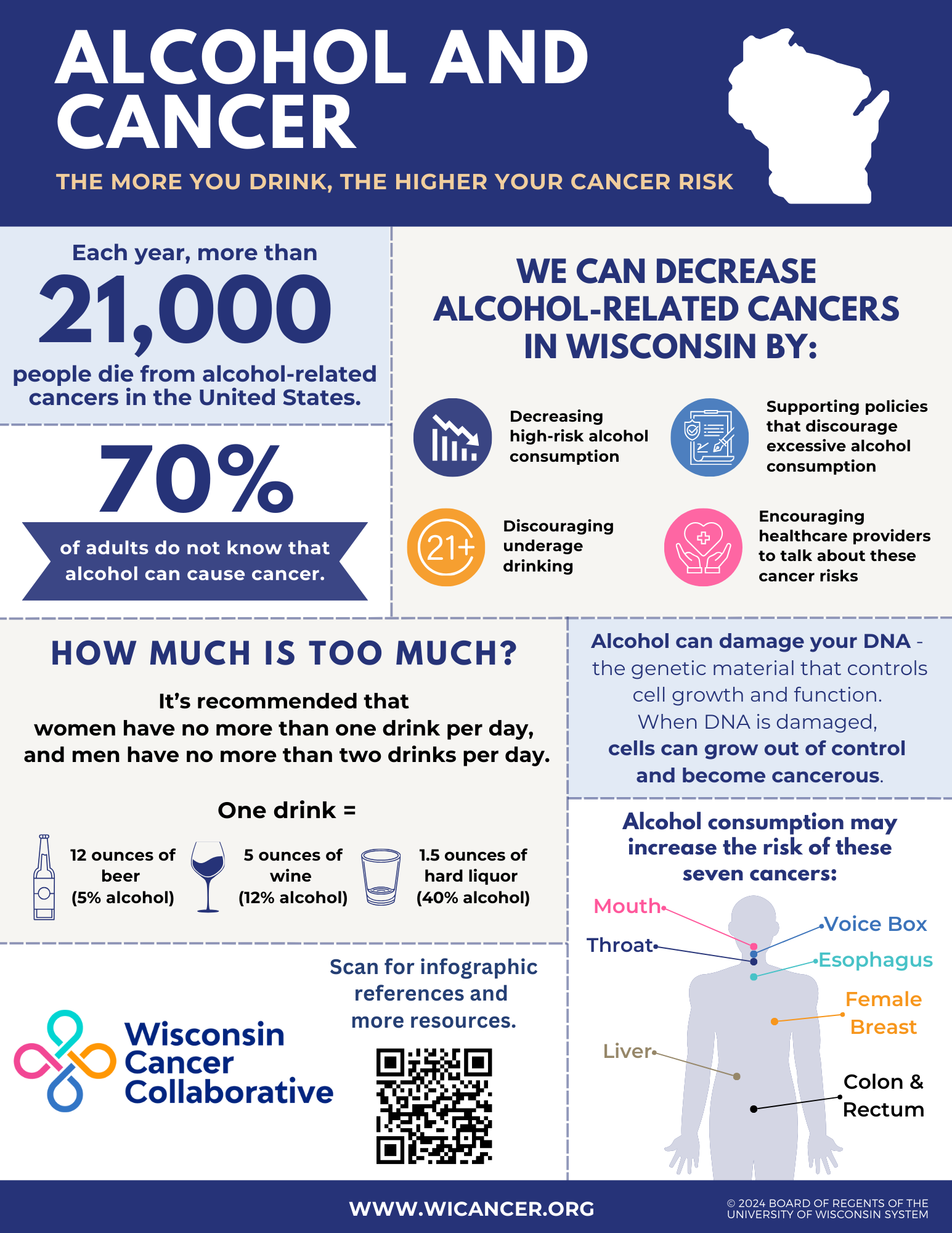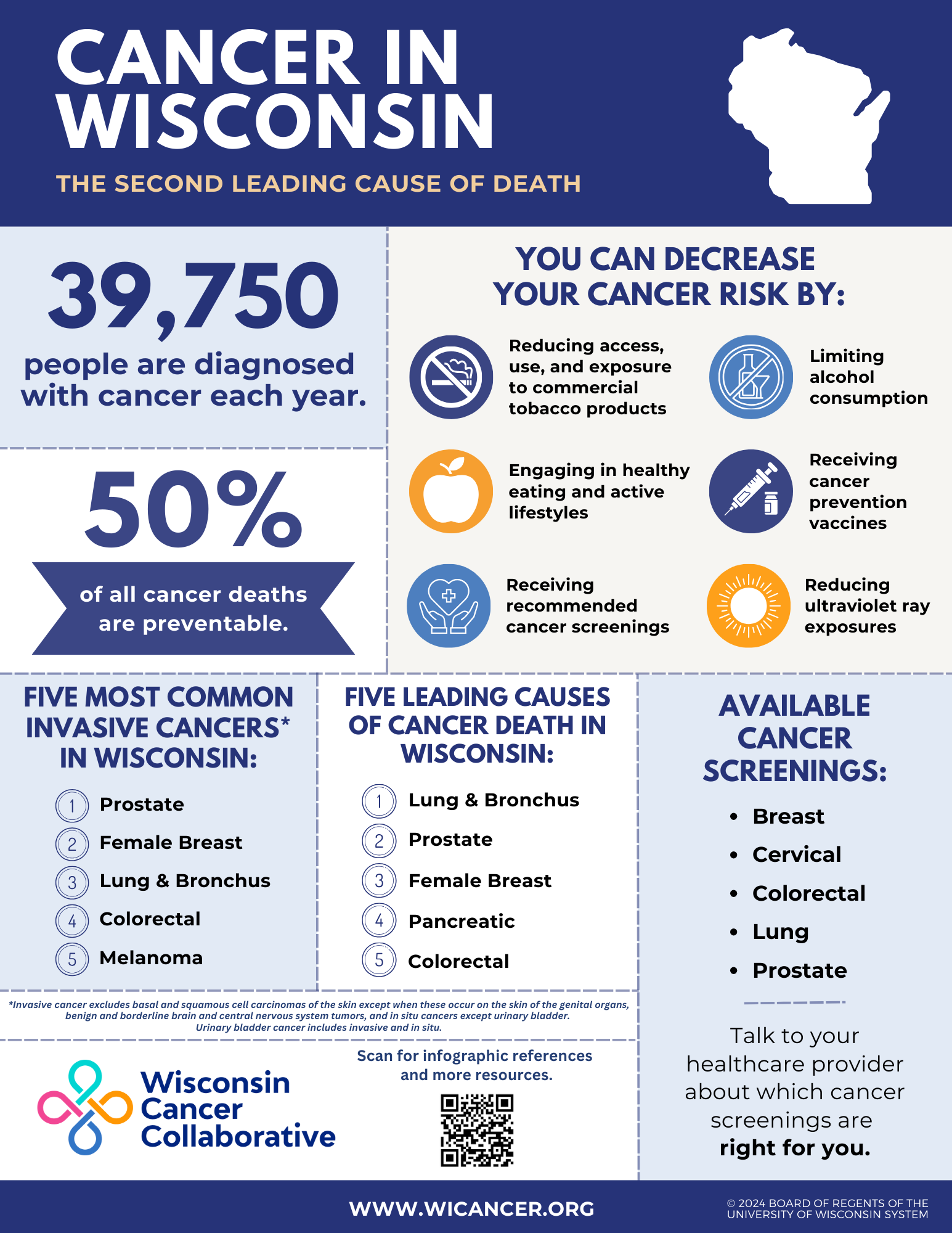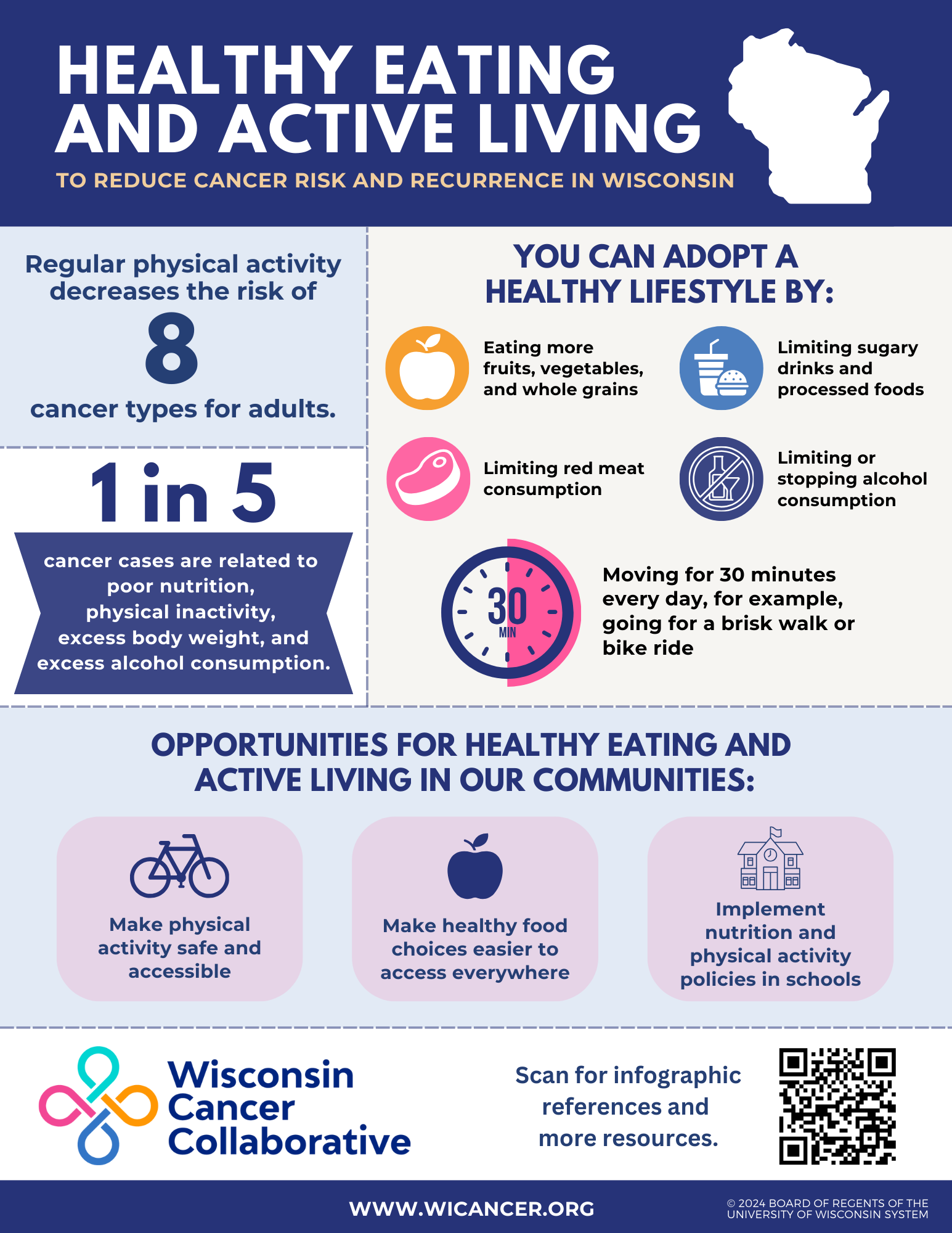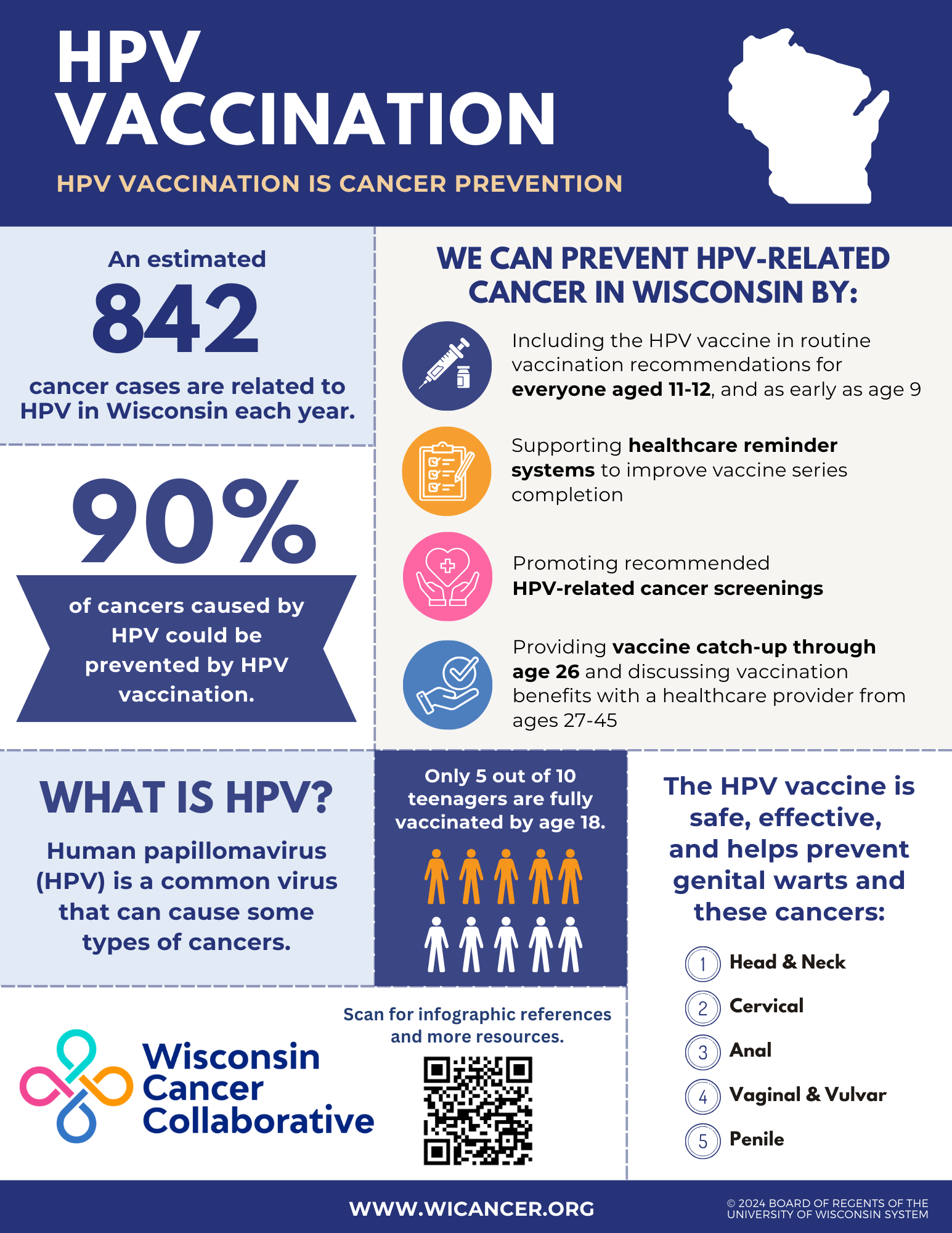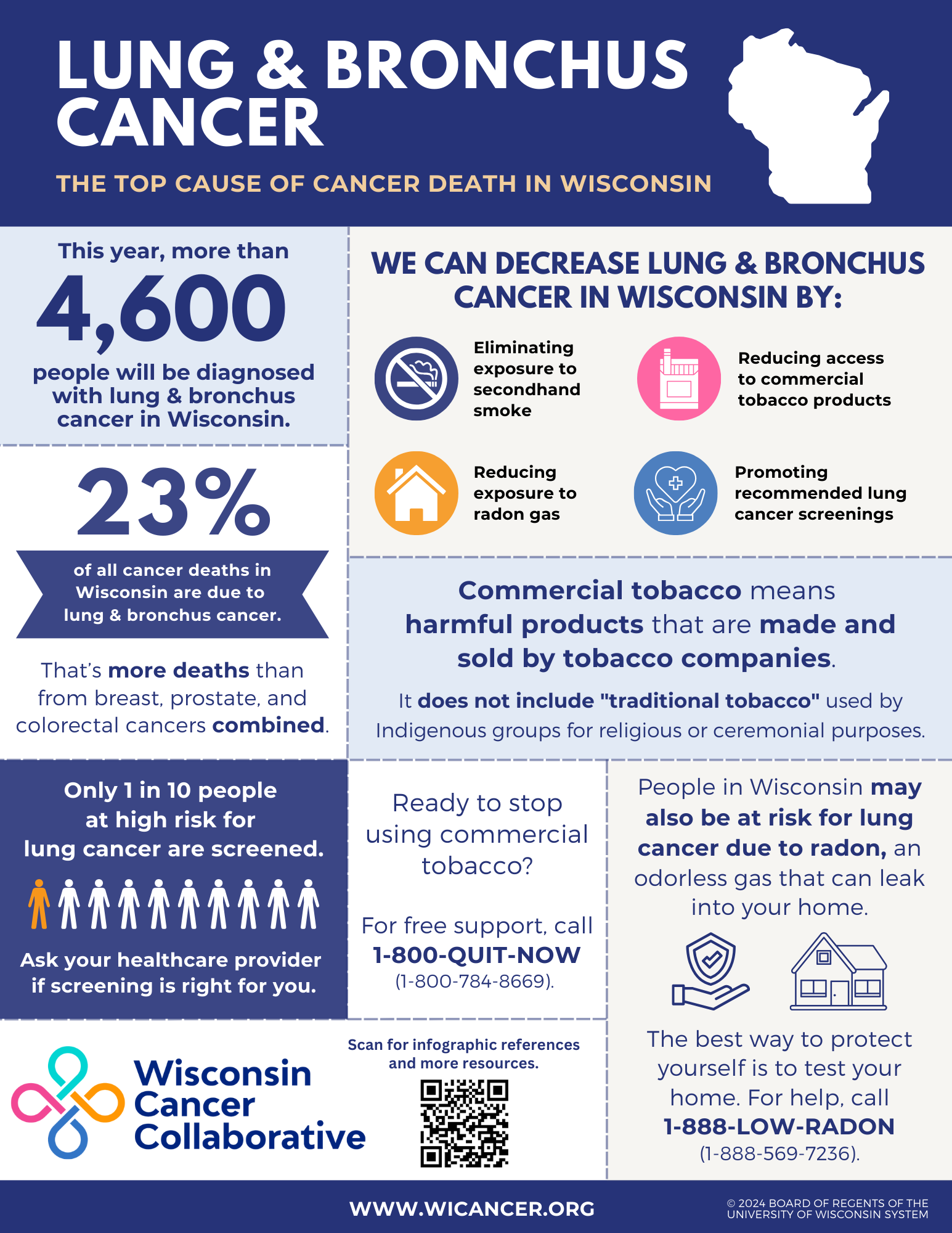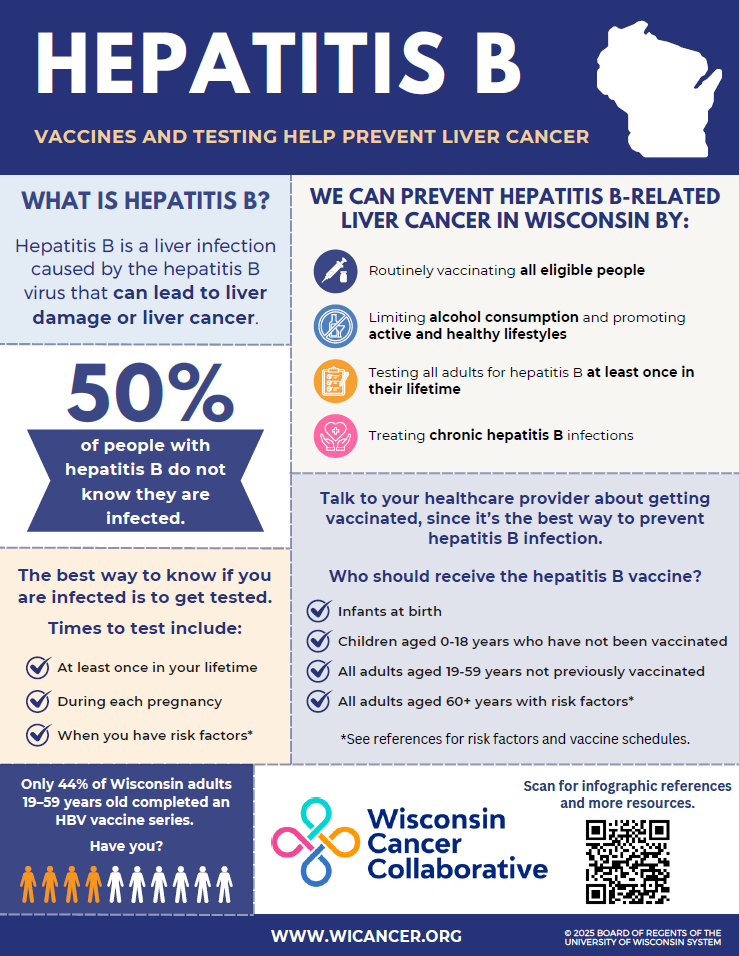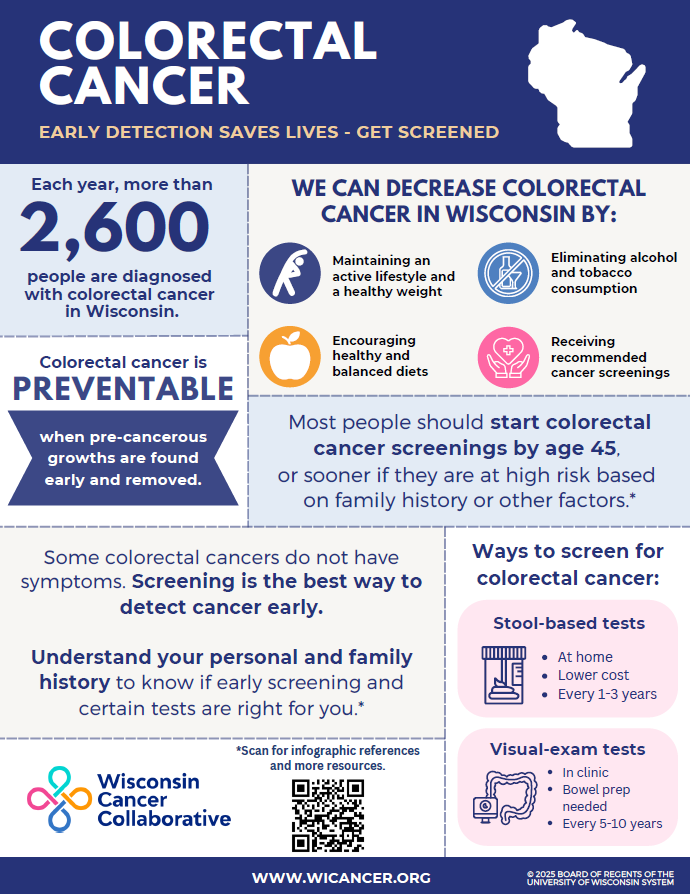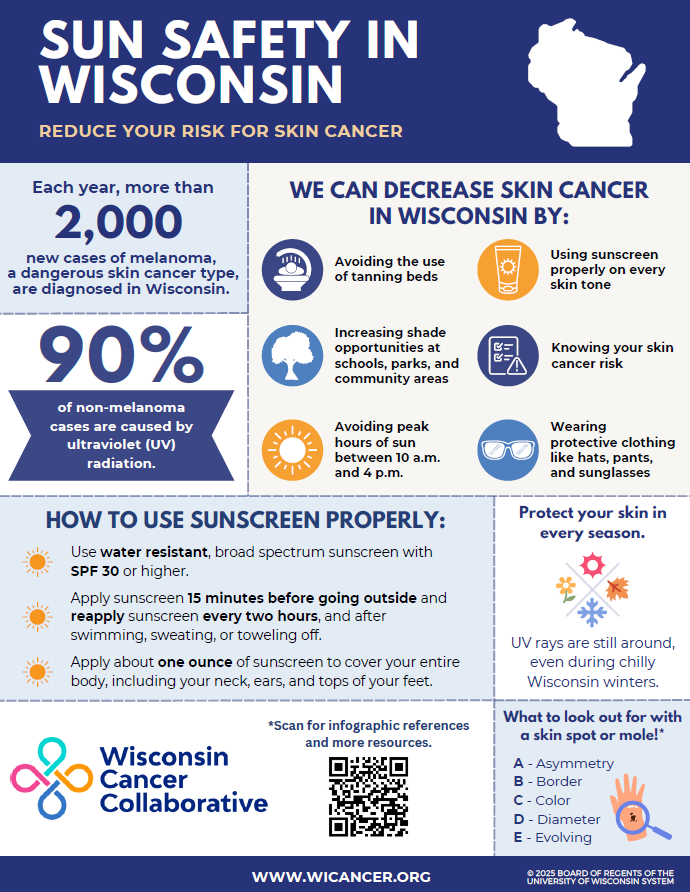Illustrating the burden of cancer
Use our Infographics Series to illustrate cancer prevention and detection strategies in easy-to-understand ways. Download and share with partners, community members, and decision makers. If you are interested in co-branding these resources, fill out this interest form.
All of our infographics are available in Spanish. We can also provide grayscale versions of the updated infographics upon request.
*Please note: We are open to edits on the Spanish translations, and welcome your feedback at [email protected].
Updated Infographics
More infographics coming soon!
Infographics References
| Fact | Source/Additional Information |
| The more alcohol you drink, the higher your risk of cancer | National Cancer Institute – Alcohol and Cancer Risk Sheet: What is the evidence that alcohol drinking can cause cancer? |
| Each year, more than 21,000 people die due to alcohol-related cancers in the United States | CDC – Alcohol and Cancer: How many people die from cancers linked to alcohol use? |
| 70% of adults are unaware that alcohol can cause cancer | American Society of Clinical Oncology - 2020 National Cancer Opinions Survey |
| How much is too much? | United States Department of Agriculture and Department of Health & Human Services - Dietary Guidelines for Americans: 2020-2025 |
| What is the equivalent of 1 drink? | National Cancer Institute – Alcohol and Cancer Risk Sheet: What is Alcohol? |
| Alcohol can damage your DNA, which can cause cancerous cell growth | CDC – Alcohol and Cancer: Why does drinking alcohol raise cancer risk? |
| Alcohol consumption may increase the risk of these 7 cancers: Mouth, Voice Box, Throat, Esophagus, Female Breast, Liver, and Colon & Rectum | National Cancer Institute – Alcohol and Cancer Risk Sheet: What is the evidence that alcohol drinking can cause cancer?
|
| Decrease alcohol-related cancers in Wisconsin by: | |
| Decreasing high risk alcohol consumption | Esser, M. B., Sherk, A., Liu, Y., Henley, S. J., & Naimi, T. S. (2024). Reducing alcohol use to prevent cancer deaths: Estimated effects among U.S. adults. American Journal of Preventive Medicine, 66(4), 725–729. https://doi.org/10.1016/j.amepre.2023.12.003
“Approximately 16,800 deaths (83% of alcohol-attributable cancer deaths, 2.8% of all cancer deaths) could have been prevented/year if adults who drank alcohol in excess of the Dietary Guidelines had instead reduced their consumption to ≤2 drinks/day for men or ≤1 drink/day for women.” |
| Supporting policies that discourage excessive alcohol consumption | For more community-based action resources, explore: The Community Guide – Preventing Excessive Alcohol Use |
| Discouraging underage drinking | For more information about the relationship between alcohol, kids, and cancer, read: Small Talks - Making the Connection |
| Encouraging healthcare providers to talk to patients about the cancer risks of alcohol | For more information about cancer risk awareness, read: Study Probes Awareness of Alcohol’s Link to Cancer |
| Fact | Source and Additional Information |
| Cancer is the second leading cause of death in Wisconsin | Wisconsin Dept. of Health Services, Division of Public Health, Office of Health Informatics. Wisconsin Vital Records Data Dashboard, https://www.dhs.wisconsin.gov/stats/deaths/causes.htm. Leading Causes of Deaths Dashboard, accessed 09/13/2024.
Data shows: 2022, Statewide, Both female and male (reported by age-adjusted rate per 100,000 people) |
| Approximately 39,750 people are diagnosed with cancer in Wisconsin each year | Siegel, R. L., Giaquinto, A. N., & Jemal, A. (2024). Cancer statistics, 2024. CA a Cancer Journal for Clinicians, 74(1), 12–49. https://doi.org/10.3322/caac.21820 |
| 50% of cancer deaths are preventable | WHO – Preventing Cancer |
| Wisconsin's five most common invasive cancers are: Prostate, Female Breast, Lung & Bronchus, Colorectal, and Melanoma |
U.S. Cancer Statistics Working Group. U.S. Cancer Statistics Data Visualizations Tool. U.S. Department of Health and Human Services, Centers for Disease Control and Prevention and National Cancer Institute; https://www.cdc.gov/cancer/dataviz, released in June 2024. Data shows: US Cancer Statistics Data Visualization – Number of New Cancers, Male & Female, All Types of Cancer, 2021, All Race and Ethnicities, Wisconsin (reported by case count) |
| Invasive cancer definition | Sourced from the footnotes of this resource: U.S. Cancer Statistics Working Group. U.S. Cancer Statistics Data Visualizations Tool. U.S. Department of Health and Human Services, Centers for Disease Control and Prevention and National Cancer Institute; https://www.cdc.gov/cancer/dataviz, released in June 2024. |
| Wisconsin's five leading causes of cancer death are: Lung & Bronchus, Prostate, Female Breast, Colorectal, and Pancreatic |
U.S. Cancer Statistics Working Group. U.S. Cancer Statistics Data Visualizations Tool. U.S. Department of Health and Human Services, Centers for Disease Control and Prevention and National Cancer Institute; https://www.cdc.gov/cancer/dataviz, released in June 2024. Data shows: US Cancer Statistics Data Visualization – Rate of Cancer Deaths, Male & Female, All Types of Cancer, All Race and Ethnicities 2022, Wisconsin (by age-adjusted rate per 100,000 people) |
| Available cancer screenings include Breast, Cervical, Colorectal, Lung, and Prostate |
CDC – Cancer Screening Tests For more information about screening guidelines and recommendations provided by the US Preventive Services Task Force, review their recommendations website |
| Decrease your cancer risk by: | |
| Reducing access, use, and exposure to commercial tobacco products | CDC – Tobacco and Cancer
*Also, check out our Lung & Bronchus Cancer infographic! |
| Limiting alcohol consumption |
National Cancer Institute – Alcohol and Cancer Risk *Also, check out our Alcohol and Cancer infographic! |
| Engaging in healthy eating and active lifestyles |
American Cancer Society - Guideline for Diet and Physical Activity for Cancer Prevention *Also, check out our Healthy Eating and Active Living infographic! |
| Receiving cancer prevention vaccines | CDC – Cancer Vaccines
*Also, check out our HPV Vaccination infographic! |
| Receiving recommended cancer screenings | American Cancer Society - Guidelines for the Early Detection of Cancer |
| Reducing ultraviolet ray exposures | American Cancer Society – UV (Ultraviolet) Radiation and Cancer Risk |
| Fact | Source/Additional Information |
| Healthy eating and active living reduces cancer risk and recurrence | American Cancer Society - Diet and Physical Activity: What’s the Cancer Connection?
American Cancer Society – Can I Do Anything to Prevent Cancer Recurrence? |
| People with an unhealthy body weight experience increased risk for 13 types of cancer | American Cancer Society Infographic: Diet and Activity Guidelines to Reduce Cancer Risk
|
| People who engage in regular physical activity experience a decreased risk of 8 types of cancer (bladder, breast, colon, endometrium, esophagus, kidney, lung, and stomach) | CDC – Health Benefits of Physical Activity for Adults |
| 1 in 5 cancer cases are related to poor nutrition, physical inactivity, excess body weight, and excess alcohol consumption | American Cancer Society Infographic: Diet and Activity Guidelines to Reduce Cancer Risk
|
| Opportunities for healthy eating & active living in our communities | For additional systems-level strategies and resources, explore: American Cancer Society Cancer Action Network’s Healthy Eating & Active Living public policy resources |
| Adopt a healthy lifestyle by: | |
| Eating more fruits, vegetables, and whole grains, limiting sugary drinks and processed foods, limiting red meat consumption, and limiting or stopping alcohol consumption | American Cancer Society: The Cancer Atlas – Body Weight, Physical Activity, Diet & Alcohol |
| Sit less and move more in ways that feel good for 30 minutes per day | Department of Health and Human Services USA - Physical Activity Guidelines for Americans (2nd Edition)
Department of Health and Human Services USA - Move Your Way |
| Fact | Source/Additional Information |
| Approximately 842 cancer cases are related to HPV in Wisconsin each year | CINA Explorer: An interactive tool for quick access to key NAACCR cancer statistics based on the Cancer in North America (CiNA) dataset from the North American Association of Central Cancer Registries. Available at www.naaccr.org/interactive-data-on-line/. [Accessed on 2024 Sep 13].
Data shows: NAACCR CiNA Explorer – Wisconsin, HPV Associated Sites, 5-Year Age-Adjusted Incidence Rates (2017-2021), Both Sexes – Average Annual Count |
| 90% of cancers caused by HPV could be prevented by HPV vaccination | CDC – Cancers Caused by HPV: Recommendations |
| Only 5 out of 10 teenagers are fully vaccinated by age 18 | Wisconsin Department of Health Services - “Vaccination coverage among Wisconsin adolescents aged 13 through 18 years, by vaccine, region of residence, and year” (Data sourced from Wisconsin Immunization Registry)
Data shows: Statewide, 2022, HPV complete (49.04% vaccination coverage)
Read more about this data at: Wisconsin Cancer Collaborative – New 2022 Data Snapshot |
| The HPV vaccine is safe, effective, and helps prevent genital warts, and helps prevent 7 types of cancer: Head & Neck, Cervical, Anal, Vaginal & Vulvar, and Penile | American Cancer Society – HPV Vaccination and Cancer Prevention |
| We can prevent HPV-related cancer in Wisconsin: | |
| HPV vaccination is recommended for everyone aged 11-12, and as early as age 9 | American Cancer Society – HPV Vaccination and Cancer Prevention |
| Supporting healthcare reminder systems to improve vaccine series completion | CDC – HPV: Outreach to Clinicians |
| Promoting recommended HPV-related cancer screenings | American Cancer Society – HPV Testing |
| HPV vaccine catch-up can occur through age 26, with potential vaccination benefits up to age 45 | CDC – HPV Vaccination Recommendations |
| Fact | Source/Additional Information |
| Lung & bronchus cancer is the leading cause of cancer death in Wisconsin | American Cancer Society – Facts and Figures 2020 |
| This year, 4,610 people will be diagnosed with lung & bronchus cancer in Wisconsin | Siegel, R. L., Giaquinto, A. N., & Jemal, A. (2024). Cancer statistics, 2024. CA a Cancer Journal for Clinicians, 74(1), 12–49. https://doi.org/10.3322/caac.21820 |
| 23% of all cancer deaths in Wisconsin are due to lung & bronchus cancer | U.S. Cancer Statistics Working Group. U.S. Cancer Statistics Data Visualizations Tool. U.S. Department of Health and Human Services, Centers for Disease Control and Prevention and National Cancer Institute; https://www.cdc.gov/cancer/dataviz, released in June 2024. |
| More people die from lung & bronchus cancer than from breast, prostate, and colorectal cancers combined | American Cancer Society – Facts and Figures 2020 |
| Commercial tobacco means harmful products that are made and sold by tobacco companies | Commercial tobacco definition used from CDC’s Tobacco Health Equity |
| Only 1 in 10 people at high risk for lung cancer are screened | American Lung Association - Wisconsin State of Lung Cancer: Screening section |
| Radon is an odorless gas that can leak into your home and cause lung cancer | Wisconsin Department of Health Services – Radon and Your Health |
| The best way to protect yourself from radon is to test your home | Wisconsin Department of Health Services – Testing Your Home for Radon |
| We can decrease lung & bronchus cancer in Wisconsin by: | |
| Eliminating secondhand smoke exposure | Warren, G. W., & Cummings, K. M. (2013). Tobacco and lung cancer: Risks, trends, and outcomes in patients with cancer. American Society of Clinical Oncology Educational Book, (33), 359–364. https://doi.org/10.14694/edbook_am.2013.33.359 |
| Reducing access to commercial tobacco products | |
| Reducing exposure to radon gas | Wisconsin Department of Health Services – Radon and Your Health |
| Promoting recommended lung cancer screenings | For more information on who is recommended for lung cancer screenings, see: US Preventive Services Task Force – Lung Cancer Screening |
| Fact | Source/Additional Information |
| Hepatitis B vaccination is cancer prevention | Prevent Cancer Foundation – Hepatitis B |
| What is hepatitis B? | CDC – Hepatitis B Basics
To learn more about hepatitis B prevalence in your community: DHS – Statewide Hepatitis C and Hepatitis B Surveillance Report, 2023 |
| 50% of people with hepatitis B do not know they are infected. | CDC – Hepatitis B Basics |
| Only 44% of Wisconsin adults 19-59 years old completed an HBV vaccine series. | WCC – Cancer Prevention Vaccine Snapshot (data sourced from WIR) |
| Times to test for hepatitis B:
· At least once in your lifetime · During each pregnancy · When you have risk factors* |
CDC – Testing for Hepatitis B
*Risk factors include: |
| Talk to your doctor about getting vaccinated for hepatitis B, as vaccination is the best way to prevent hepatitis B infection. | Immunize.Org – Hepatitis B: Questions and Answers
CDC – Hepatitis B Vaccine |
| Who should receive the hepatitis B vaccine?
· Infants at birth · Children aged 0-18 years who have not been vaccinated · All adults aged 19-59 years not previously vaccinated · All adults aged 60+ years with risk factors* |
To check your personal vaccination record, visit the Wisconsin Immunization Registry
Updated 12-15-25: WI DHS continues to recommend routine administration of the hepatitis B vaccine at birth for all newborns and to continue the practice of the standard 3-dose vaccine series following changes made as a result of the December 4-5, 2025 CDC Advisory Committee on Immunization Practices (ACIP). [DPH Numbered Memo 2025-05] *Risk factors include: Hepatitis B Foundation - High Risk Groups CDC – Who is at Risk for Hepatitis B
|
| We can prevent Hepatitis B-related liver cancer in Wisconsin by: | |
| Routinely vaccinating all eligible people | CDC – Hepatitis B Prevention and Control |
| Limiting alcohol consumption and promoting active and healthy lifestyles | ACS – Can Liver Cancer Be Prevented? |
| Testing all adults for hepatitis B at least once in their lifetime | CDC – Hepatitis B Prevention and Control |
| Treating chronic hepatitis B infections | Hepatitis B Foundation – Treatment Options for Hepatitis B |
| Fact | Source/Additional Information |
| Early detection saves lives – get screened | CDC – Health and Economic Benefits of Colorectal Cancer Interventions |
| More than 2,600 people are diagnosed with colorectal cancer in Wisconsin each year. | ACS – Cancer Facts & Figures 2024
(data found on Table 2 – 2,040 predicted new cases of melanoma of the skin for Wisconsin in 2024)
For more Wisconsin statistics related to CRC: ACS – Colorectal Cancer Facts & Figures 2023-2025 |
| Colorectal cancer is preventable when pre-cancerous growths and found early and removed. | ACS – Can Colorectal Polyps and Cancer be Found Early?
|
| Most people should start regular colorectal cancer screenings by age 45. | USPSTF – Colorectal Cancer: Screening |
| Some people should start screening sooner if they are at high risk based on family history or other factors*. | ACS – Colorectal Cancer Risk Factors
ACS – American Cancer Society |
| Some colorectal cancers do not have symptoms. Screening is the best way to know. | NCI – Colorectal Cancer Screening (PDQ) – Patient Version |
| Understand your personal and family history to know if early screening and certain tests are right for you. | Colorectal Cancer Alliance – Family History and Colorectal Cancer
Colorectal Cancer Alliance – Genetics and Inherited Conditions |
| There are many ways to screen for colorectal cancer: | |
| Stool-based tests | CDC – Screening for Colorectal Cancer: Types of Tests
Colorectal Cancer Alliance – Screening Methods |
| Visual-exam tests | |
| We can decrease colorectal cancer in Wisconsin by: | |
| Maintaining an active lifestyle and a healthy weight | NCI – Colorectal Cancer Prevention (PDQ) – Patient Version |
| Encouraging healthy and balanced diets | |
| Eliminating alcohol and tobacco consumption | CDC – Reducing Risk for Colorectal Cancer |
| Receiving recommended cancer screenings | ACS – Can Colorectal Cancer Be Prevented? |
| Fact | Source and Additional Information |
| Each year, more than 2,000 new cases of melanoma are diagnosed in Wisconsin. | ACS – Cancer Facts & Figures 2025
(data found on Table 2 – 2,230 predicted new cases of melanoma of the skin for Wisconsin in 2025) |
| Melanoma is a dangerous type of skin cancer. | Skin Cancer Foundation - Melanoma Overview: A Dangerous Skin Cancer
What’s the difference between melanoma and non-melanoma skin cancer? - ACS – What is Melanoma?
|
| 90% of nonmelanoma skin cancer cases are caused by ultraviolet (UV) radiation. | Kim, Y., & He, Y. Y. (2014). Ultraviolet radiation-induced non-melanoma skin cancer: Regulation of DNA damage repair and inflammation. Genes & diseases, 1(2), 188–198. https://doi.org/10.1016/j.gendis.2014.08.005 |
| Protect your skin in every season. UV rays are still around, even during chilly Wisconsin winters. | ACS – Preventing Skin Cancer |
| What to look out for with a skin spot or mole! | American Academy of Dermatology Association – The ABCDEs of Melanoma
Skin Cancer Foundation – Melanoma Warning Signs |
| Sunscreen tips: | |
| Use water-resistant, broad-spectrum sunscreen with SPF 30 or higher. | Prevent Cancer Foundation – What to Know When Buying Sunscreen |
| Apply sunscreen 15 minutes before going outside and reapply sunscreen every two hours, and after swimming, sweating, or toweling off. | ACS – How to Use Sunscreen |
| Apply about one ounce of sunscreen to cover your entire body, including your neck, ears, and tops of your feet. | American Academy of Dermatology Association – Sunscreen FAQs |
| We can decrease skin cancer in Wisconsin by: | |
| Avoiding the use of tanning beds | American Academy of Dermatology Association – Indoor Tanning
Did you know? People who first use a tanning bed before the age of 35 increase their risk for melanoma by 75%. - The International Agency for Research on Cancer Working Group on Artificial Ultraviolet I SC The association of use of sunbeds with cutaneous malignant melanoma and other skin cancers: a systematic review. Int. J. Cancer. 2006;120(5):1116–1122. doi: 10.1002/ijc.22453. |
| Using sunscreen properly on every skin tone | ACS – What People of Color Need to Know About Sun Protection and Skin Cancer |
| Increasing shade opportunities at schools, parks, and community areas | Holman, D. M., Kapelos, G. T., Shoemaker, M., & Watson, M. (2018). Shade as an Environmental Design Tool for Skin Cancer Prevention. American journal of public health, 108(12), 1607–1612. https://doi.org/10.2105/AJPH.2018.304700 |
| Knowing your skin cancer risk | Prevent Cancer Foundation – Skin Cancer: Know Your Risk |
| Avoiding peak hours of sun between 10 a.m. and 4 p.m. | ACS – How to Protect Your Skin from UV Rays |
| Wearing protective clothing like hats, pants, and sunglasses | ACS – Preventing Skin Cancer |

